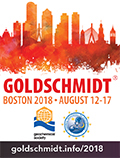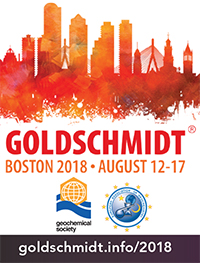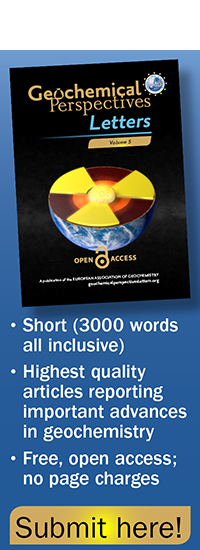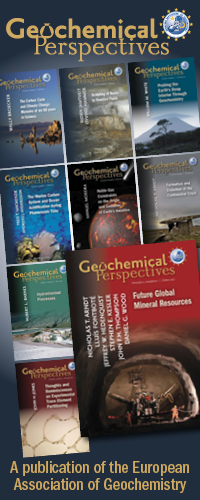Society News

As a new year is just around the corner, it is time to
join the EAG or renew your membership. Make sure you receive all 2018 issues of Elements and Geochemical Perspectives by joining/renewing before 31 December.
2018 membership fees are unchanged: 25 Euros for professionals or 100 Euros for 5 years | 15 Euros for students or 35 Euros for 3 years. Check all the member benefits.
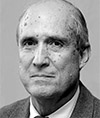
The 2nd Bob Berner Lecture will take place at the 2018 Goldschmidt Conference in Boston. The lecturer should be a mid-career scientist who has shown exceptional ability to define globally important biogeochemical processes, has developed new understanding(s), and has significantly advanced the corresponding area of research. Find out more about the Berner Lecture.
Nomination deadline is 15 January.
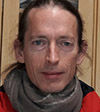
Alex Hofmann is just back from Dar-es-Salaam in Tanzania, and will be travelling on to Nigeria in January for the final leg of his 2017 EAG-GS Outreach tour in Africa. Alex has been visiting universities across the continent to present a short course entitled "Early Earth Life and Mineral Systems", exploring the relationship between surface processes, evolution and habitat of life and the formation of mineral deposits on the early Earth. Find out more about the EAG & GS Outreach Program.
New in Geochemical Perspectives Letters

A.A. Migdisov, X. Guo, H. Xu, A.E. Williams-Jones, C.J. Sun, O. Vasyukova, I. Sugiyama, S. Fuchs, K. Pearce, R. Roback
Conventional wisdom holds that aqueous solutions are the only non-magmatic fluids capable of concentrating metals in the Earth’s crust. The role of hydrocarbons in metal concentration is relegated to providing geochemical barriers at which the metals are reduced and immobilised. Read more

W. Lu, S. Wörndle, G.P. Halverson, X. Zhou, A. Bekker, R.H. Rainbird, D.S. Hardisty, T.W. Lyons, Z. Lu
The Neoproterozoic Bitter Springs Anomaly (BSA; 810–800 Ma) is characterised by an 8 ‰ negative d13C excursion and is coeval with multiple indicators of increasing oxygenation of the ocean and atmosphere. Here, we use carbonate iodine contents to provide the first constraints on the evolution of local upper ocean redox conditions spanning the BSA. Read more

C. Ballhaus, R. Wirth, R.O.C. Fonseca, H. Blanchard, W. Pröll, A. Bragagni, T. Nagel, A. Schreiber, S. Dittrich, V. Thome, D.C. Hezel, R. Below, H. Cieszynski
Since ultra-high pressure (UHP) minerals have been discovered in ophiolites from Tibet and the Polar Urals, it is speculated that the mantle sections of ophiolites may originate deep within the mantle. The UHP minerals are frequently found together with ultra-reduced silicides, carbides, and nitrides. Read more

S. Rivas-Lamelo, K. Benzerara, C.T. Lefèvre, C.L. Monteil, D. Jézéquel, N. Menguy, E. Viollier, F. Guyot, C. Férard, M. Poinsot, F. Skouri-Panet, N. Trcera, J. Miot, E. Duprat
The role of microorganisms in the geochemical cycle of P has received great interest in the context of enhanced biological phosphorus removal and phosphorite formation. Here, we combine scanning and transmission electron microscopies, confocal laser scanning microscopy and synchrotron-based x-ray microfluorescence to analyse the distribution of P at the oxic-anoxic interface in the water column of the ferruginous Lake Pavin. Read more

N. Badullovich, F. Moynier, J. Creech, F.-Z. Teng, P.A. Sossi
Tin exists both under the 2+ and 4+ oxidation states in igneous systems, and thus its geochemical behaviour changes as a function of oxygen fugacity. To characterise the redox state of Sn during magmatic differentiation and how this affects its isotope composition, we have measured Sn isotopic and elemental abundances in a suite of samples from the Kilauea Iki lava lake. Read more
Geochemical Perspectives Letters is published by the European Association of Geochemistry. It is fully society owned, open-access and carries no page charges. We are open to submissions describing high-impact science at the leading edge of any field of geochemistry. SUBMIT HERE
EAG Blogosphere

[By Marco Mangayayam] Looking at minerals on a nanoscale helps us to understand their behaviour, and we can certainly learn from them for our advantage. Minerals that are highly reactive in ambient environments are not usually well understood because of difficulties in sample preparation and analysis. Read more

[By Laura Newsome] Thanks to support from the EAG I was able to attend the 2017 conference of the International Society of Subsurface Microbiology, held in Rotorua, New Zealand. Rotorua is an amazing city due to its geothermal activity. Read more

[By Mabrouk Sami] I am really grateful to the European Association of Geochemistry (EAG) for their support to attend the Conference on Accessory Minerals (CAM–2017), which took place from 13–17 September 2017 in Vienna, Austria, and Bratislava, Slovak Republic. Read more

[By Eszter Sendula] With the support of EAG, last summer I was able to attend the biennial international conference of European Current Research On Fluid Inclusions (ECROFI), organized in Nancy (France). Read more
Geochemistry making the news

[Scientific American] Thawing glaciers may speed up acidification of ocean water. Melting glaciers might be making ocean water more acidic, an unexpected finding that's given scientists new cause for concern. Read more

[Science Daily] Geophysicists uncover new evidence for an alternative style of plate tectonics. When renowned University of Toronto (U of T) geophysicist J. Tuzo Wilson cemented concepts in the emerging field of plate tectonics in the 1960s, he revolutionized the study of Earth's physical characteristics and behaviours. Read more

[Science] Spongelike crystal could make it easier for natural gas–powered cars to store fuel. As an alternative automotive fuel, natural gas, or methane, doesn't get a lot of attention. Millions of environmentally friendly, natural gas–powered vehicles cruise the world’s roads, but they still account for just a tiny fraction of new autos sold. Read more

[NASA] Scientists were already excited to learn this summer that New Horizons’ next flyby target – a Kuiper Belt object a billion miles past Pluto -- might be either peanut-shaped or even two objects orbiting one another. Now new data hints that 2014 MU69 might have orbital company: a small moon. Read more

[Science Daily] New research by Brown University geochemists provides new insights on the scale at which Earth's mantle varies in chemical composition. The findings could help scientists better understand the mixing process of mantle convection, the slow churning that drives the movement of Earth's tectonic plates. Read more
Job opportunities


Receive job ads as they are posted: like us on Facebook or follow us on Twitter (@EAG_).
To post a position on the EAG job page (free of charge): click here.
PhD & MSc positions:
 One PhD position available at the University of Liege (Belgium) in the field of petrology-volcanology to investigate magmatic processes under one volcano of the andean arc (Chili). - University of Liege
One PhD position available at the University of Liege (Belgium) in the field of petrology-volcanology to investigate magmatic processes under one volcano of the andean arc (Chili). - University of Liege
 Two PhD positions available in Environmental Biogeochemistry and Soil Science to study arsenic uptake and speciation at the soil/plant and plant/mammalian interface. - University of Bern
Two PhD positions available in Environmental Biogeochemistry and Soil Science to study arsenic uptake and speciation at the soil/plant and plant/mammalian interface. - University of Bern
 2 PhD Positions: Winter Soil Processes in Transition - A research project to advance the process-based understanding of the function of soil biogeochemical processes in cold region - University of Waterloo
2 PhD Positions: Winter Soil Processes in Transition - A research project to advance the process-based understanding of the function of soil biogeochemical processes in cold region - University of Waterloo
 PhD Studentship - Turning Waste to Carbon Capture as Facilitated by Microbes - University of Southampton
PhD Studentship - Turning Waste to Carbon Capture as Facilitated by Microbes - University of Southampton
 PhD Studentship on Microbial controls on greenhouse gas capture via fluid-rock interactions - University of Southampton
PhD Studentship on Microbial controls on greenhouse gas capture via fluid-rock interactions - University of Southampton
 PhD studentship in Marine Microbial Biogeochemistry - University of Southampton
PhD studentship in Marine Microbial Biogeochemistry - University of Southampton
 PhD position in geochemistry/cosmochemistry - California Institute of Technology
PhD position in geochemistry/cosmochemistry - California Institute of Technology
 How the polar ocean gets rid of CO2: Blue carbon burial in Arctic and Antarctic shelf seas - University of Leeds
How the polar ocean gets rid of CO2: Blue carbon burial in Arctic and Antarctic shelf seas - University of Leeds
 Open positions: Biochemical, Genetic, Metabolic, and Isotopic Constraints on an Ancient Thiobiosphere - Multiple locations
Open positions: Biochemical, Genetic, Metabolic, and Isotopic Constraints on an Ancient Thiobiosphere - Multiple locations
 Planetary science geochemistry PhD positions - University of Manchester
Planetary science geochemistry PhD positions - University of Manchester
 PhD position in eco-hydrology (Hydrological constraints on Rare Earth Elements dynamics in the regolith-plant continuum) - LIST Luxembourg
PhD position in eco-hydrology (Hydrological constraints on Rare Earth Elements dynamics in the regolith-plant continuum) - LIST Luxembourg
PostDoctoral and Fellowship positions:
 2-year Postdoc Position - Building the crust of Mercury. - University of Liege
2-year Postdoc Position - Building the crust of Mercury. - University of Liege
 Postdoctoral Researcher position in MD simulations - McGill University
Postdoctoral Researcher position in MD simulations - McGill University
 Postdoctoral Researcher position in Experimental Petrology - McGill University
Postdoctoral Researcher position in Experimental Petrology - McGill University
 Research Associate in Fluid-Rock-Gas Geochemistry - University College London
Research Associate in Fluid-Rock-Gas Geochemistry - University College London
 3-year Post-doc position in “Biogeochemical processes in the land-ocean interface” - Norwegian Institute for Water Research/University of Agder
3-year Post-doc position in “Biogeochemical processes in the land-ocean interface” - Norwegian Institute for Water Research/University of Agder
 Research Fellow / Akademische(r) Rat/Rätin auf Zeit (Salary Scale A13, 100%) - Leibniz Universität Hannover
Research Fellow / Akademische(r) Rat/Rätin auf Zeit (Salary Scale A13, 100%) - Leibniz Universität Hannover
 Project Title: Model development for flow and geomechanical coupling in fracture networks to assess CO2 leakage through the primary caprock during CO2 storage operations - Heriot-Watt University
Project Title: Model development for flow and geomechanical coupling in fracture networks to assess CO2 leakage through the primary caprock during CO2 storage operations - Heriot-Watt University
 Full-time, 12-month Laboratory Manager / Research Associate in the School of Geosciences Stable Isotope Lab - University of South Florida
Full-time, 12-month Laboratory Manager / Research Associate in the School of Geosciences Stable Isotope Lab - University of South Florida
 Postdoctoral position in geochemistry/cosmochemistry - California Institute of Technology
Postdoctoral position in geochemistry/cosmochemistry - California Institute of Technology
 Modelling Benthic Biogeochemical Dynamics in Arctic Sediments from the Local to the Regional Scale - University of Bristol
Modelling Benthic Biogeochemical Dynamics in Arctic Sediments from the Local to the Regional Scale - University of Bristol
 Open positions: Biochemical, Genetic, Metabolic, and Isotopic Constraints on an Ancient Thiobiosphere - Multiple locations
Open positions: Biochemical, Genetic, Metabolic, and Isotopic Constraints on an Ancient Thiobiosphere - Multiple locations
 Postdoctoral Research Fellowship in Geochemistry (hydrothermal laboratory experiments of environmental conditions on Mars and potentially validation for small planetary bodies) - University of Oslo
Postdoctoral Research Fellowship in Geochemistry (hydrothermal laboratory experiments of environmental conditions on Mars and potentially validation for small planetary bodies) - University of Oslo
 Two Postdoctoral positions in Biogeochemical and Ecosystem Modeling - Global Water Futures Program, Ecohydrology Research Group, University of Waterloo
Two Postdoctoral positions in Biogeochemical and Ecosystem Modeling - Global Water Futures Program, Ecohydrology Research Group, University of Waterloo
Faculty, Technical and other positions:
 Full-time academic position in Geochemistry of extreme environments - Université Libre de Bruxelles
Full-time academic position in Geochemistry of extreme environments - Université Libre de Bruxelles
 Position in Solid Earth Petrology/Geochemistry - University of Florida
Position in Solid Earth Petrology/Geochemistry - University of Florida
